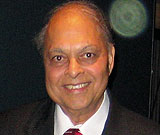Mobilizing the Indian American Community
|
|

|
|
INDER SINGH
|
|
By Inder Singh
|
Indian community activists have mobilized the community to propagate information, garner support, and seek cooperation whenever major issues and concerns have arisen. In the early part of the twentieth century, when the number of Indian nationals in the United States was relatively small, they faced racial prejudice and hostility from the local population. Indian students, upon graduation, failed to get jobs commensurate with their qualifications. The Indian nationals attributed the discrimination and inequity to their being nationals of “slave” India. The unfair treatment compelled them to become part of Gadar Movement which aimed at getting independence for India with the force of arms. It became a major effort to mobilize the Indian nationals to fight against the British rule. The most recent example of community mobilization took place when Government of India decided to charge heavy fee and penalties for the retroactive enforcement of rules for “surrender” of Indian Passport by Indian nationals who had acquired foreign citizenship. The Global Organization of People of Indian Origin (GOPIO) initiated an on-line petition to Prime Minister of India for the relaxation of the stringent rules. In a matter of ten days, over 32,000 people signed the petition and Govt. of India amended the rules to be more comfortable to overseas Indians. So it proved again the community mobilization has an impact to achieve the common goals the community living outside India.
Early Immigrants
Indians started coming to the United States in the beginning of the twentieth century for economic opportunities and for higher education. As the number of Indian nationals increased within a span of few years, they started facing discrimination and hostility. Most of the Indian students faced similar situation, when after graduation, they could not get jobs matching their qualifications. The new immigrants needed jobs badly, accepted low wages and poor working conditions. They found only menial jobs in factories, lumber mills and railroad construction and many times traveled from place to place in search of work. The employers preferred the Indians to the whites, but the unions despised the immigrants. As the number of Indian workers increased within a span of few years, they started facing discrimination and hostility which sometimes led to racial riots, resulting in certain cases, loss of life and property.
In 1907, Indians became the victims of brutal assault deliberately directed at them in Bellingham, a milling town in Washington State, where about 250 Indians were employed in various lumber mills. A mob of about 500 men attacked boarding houses and mills, forcibly expelling Hindus (Indians had collective identity as Hindus irrespective of their faith). The chief objective of the vicious attack was to “scare them so badly that they will not crowd white labor out of the mills.” The town had a small police force which was overpowered by the white mob. Indians became victims of racial violence, bigotry, and prejudice. The nightmarish incident forced the Indians to leave the town in fear for their life and safety. The Chinese and Japanese governments, in similar cases, negotiated compensation with American government on behalf of their overseas nationals for life and property losses. But the British embassy which represented India, did not even register any protest with the American government against attacks on
Indian nationals. Indians were relatively new in the United States, were generally uneducated and thus were afraid of banding together to fight against injustice.
—To be continued
|
|
Inder Singh regularly writes and speaks on Indian Diaspora. He is Chairman of Global Organization of People of Indian Origin
(GOPIO). He was president of GOPIO from 2004-2009, president of National Federation of Indian American Associations
(NFIA) from 1988-92 and was the founding president of Federation of Indian Associations in Southern California. He can be reached at
indersingh-usa@hotmail.com. |
| |
|
|
|
September 2011
|
|


|
|
|
|